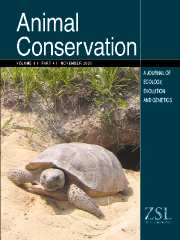Article contents
Influence of population isolation on genetic variation and demography in Seychelles warblers: a field experiment
Published online by Cambridge University Press: 30 March 2001
Abstract
Between 1959 and 1968 the entire world population of Seychelles warblers (Acrocephalus sechellensis) comprised only 26–29 individuals entirely confined to Cousin Island (26 ha). Through conservation actions the island population has reached a carrying capacity of ca 320 birds since 1982. The warbler population has significantly lower levels of genetic variation, as determined by multilocus DNA fingerprinting, compared with its mainland relative, the Australian warbler (Acrocephalus australis) and other outbred natural bird populations (mean band sharing coefficients are 0.50, 0.22 and 0.21, respectively), and has a very low annual reproductive rate of 0.28 yearlings per breeding pair. Therefore some degree of inbreeding may have occurred in this population.
The relatively low level of genetic variation is not directly responsible for this low reproductive output since breeding pairs that were transferred to the islands of Aride (68 ha) and Cousine (29 ha) with similar vegetation and climate, but with higher year-round insect food abundance, had significantly higher fecundity and survival. In contrast, no difference in reproductive success was observed between incestuous breeding pairs and non-incestuous breeding pairs.
In addition, annual production of yearlings by pairs on Aride was on average 44 times higher than that by the same pairs on Cousin before the transfer. Annual production of yearlings by pairs on Cousine, that were as inbred as those on Aride, was on average five times higher than that by the same pairs on Cousin before the transfer. Eight years after translocation, the Aride population had grown to over 1000 birds, and six years after translocation, the Cousine population had grown to 186 birds.
The experiments, controlled for group size, breeding partner, breeder age and experience, showed that the differences in reproductive success by warblers on the three islands cannot be due to genetic differences because of similar band-sharing similarities, but seem entirely accounted for by differences in food supply. Although the amount of genetic variation in the Seychelles warblers is relatively low, the demographic parameters do not indicate apparent signs of inbreeding depression in these populations.
- Type
- Research Article
- Information
- Copyright
- © 1998 The Zoological Society of London
- 11
- Cited by


